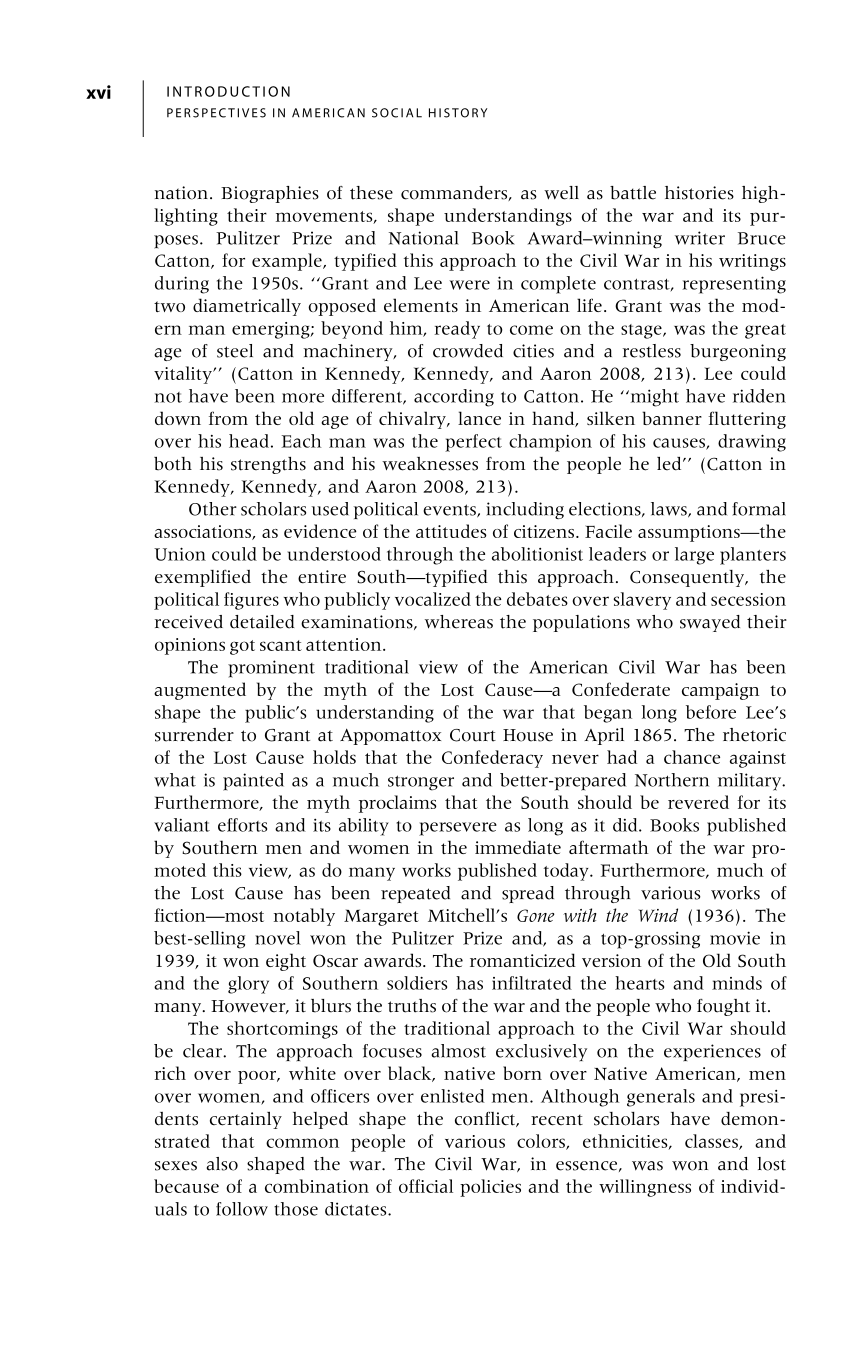nation. Biographies of these commanders, as well as battle histories high-
lighting their movements, shape understandings of the war and its pur-
poses. Pulitzer Prize and National Book Award–winning writer Bruce
Catton, for example, typified this approach to the Civil War in his writings
during the 1950s. ‘‘Grant and Lee were in complete contrast, representing
two diametrically opposed elements in American life. Grant was the mod-
ern man emerging; beyond him, ready to come on the stage, was the great
age of steel and machinery, of crowded cities and a restless burgeoning
vitality’’ (Catton in Kennedy, Kennedy, and Aaron 2008, 213). Lee could
not have been more different, according to Catton. He ‘‘might have ridden
down from the old age of chivalry, lance in hand, silken banner fluttering
over his head. Each man was the perfect champion of his causes, drawing
both his strengths and his weaknesses from the people he led’’ (Catton in
Kennedy, Kennedy, and Aaron 2008, 213).
Other scholars used political events, including elections, laws, and formal
associations, as evidence of the attitudes of citizens. Facile assumptions—the
Union could be understood through the abolitionist leaders or large planters
exemplified the entire South—typified this approach. Consequently, the
political figures who publicly vocalized the debates over slavery and secession
received detailed examinations, whereas the populations who swayed their
opinions got scant attention.
The prominent traditional view of the American Civil War has been
augmented by the myth of the Lost Cause—a Confederate campaign to
shape the public’s understanding of the war that began long before Lee’s
surrender to Grant at Appomattox Court House in April 1865. The rhetoric
of the Lost Cause holds that the Confederacy never had a chance against
what is painted as a much stronger and better-prepared Northern military.
Furthermore, the myth proclaims that the South should be revered for its
valiant efforts and its ability to persevere as long as it did. Books published
by Southern men and women in the immediate aftermath of the war pro-
moted this view, as do many works published today. Furthermore, much of
the Lost Cause has been repeated and spread through various works of
fiction—most notably Margaret Mitchell’s Gone with the Wind (1936). The
best-selling novel won the Pulitzer Prize and, as a top-grossing movie in
1939, it won eight Oscar awards. The romanticized version of the Old South
and the glory of Southern soldiers has infiltrated the hearts and minds of
many. However, it blurs the truths of the war and the people who fought it.
The shortcomings of the traditional approach to the Civil War should
be clear. The approach focuses almost exclusively on the experiences of
rich over poor, white over black, native born over Native American, men
over women, and officers over enlisted men. Although generals and presi-
dents certainly helped shape the conflict, recent scholars have demon-
strated that common people of various colors, ethnicities, classes, and
sexes also shaped the war. The Civil War, in essence, was won and lost
because of a combination of official policies and the willingness of individ-
uals to follow those dictates.
xvi
I N T R O D U C T I O N
P E R S P E C T I V E S I N A M E R I C A N S O C I A L H I S T O R Y




















































































































































































































































































